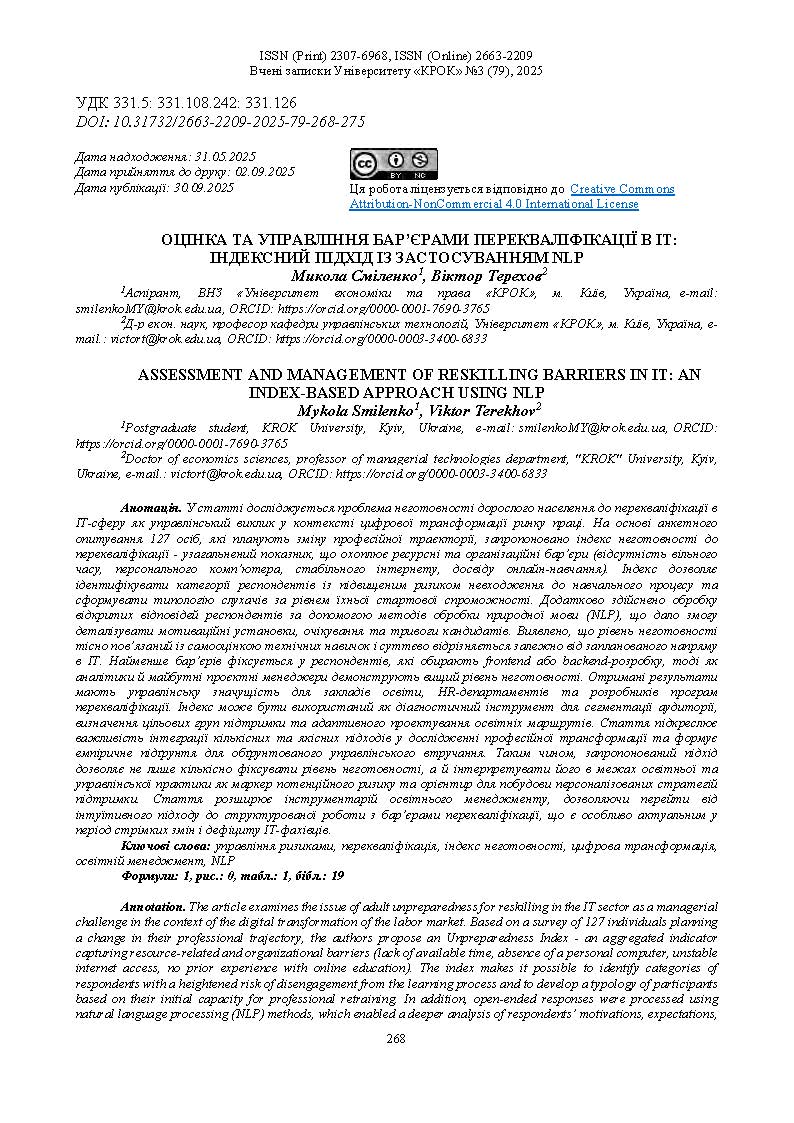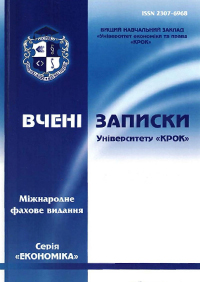ОЦІНКА ТА УПРАВЛІННЯ БАР’ЄРАМИ ПЕРЕКВАЛІФІКАЦІЇ В ІТ: ІНДЕКСНИЙ ПІДХІД ІЗ ЗАСТОСУВАННЯМ NLP
DOI:
https://doi.org/10.31732/2663-2209-2025-79-268-276Ключові слова:
перекваліфікація, індекс неготовності, цифрова трансформація, освітній менеджмент, NLPАнотація
У статті досліджується проблема неготовності дорослого населення до перекваліфікації в ІТ-сферу як управлінський виклик у контексті цифрової трансформації ринку праці. На основі анкетного опитування 127 осіб, які планують зміну професійної траєкторії, запропоновано індекс неготовності до перекваліфікації - узагальнений показник, що охоплює ресурсні та організаційні бар’єри (відсутність вільного часу, персонального комп’ютера, стабільного інтернету, досвіду онлайн-навчання). Індекс дозволяє ідентифікувати категорії респондентів із підвищеним ризиком невходження до навчального процесу та сформувати типологію слухачів за рівнем їхньої стартової спроможності. Додатково здійснено обробку відкритих відповідей респондентів за допомогою методів обробки природної мови (NLP), що дало змогу деталізувати мотиваційні установки, очікування та тривоги кандидатів. Виявлено, що рівень неготовності тісно пов’язаний із самооцінкою технічних навичок і суттєво відрізняється залежно від запланованого напряму в ІТ. Найменше бар’єрів фіксується у респондентів, які обирають frontend або backend-розробку, тоді як аналітики й майбутні проєктні менеджери демонструють вищий рівень неготовності. Отримані результати мають управлінську значущість для закладів освіти, HR-департаментів та розробників програм перекваліфікації. Індекс може бути використаний як діагностичний інструмент для сегментації аудиторії, визначення цільових груп підтримки та адаптивного проектування освітніх маршрутів. Стаття підкреслює важливість інтеграції кількісних та якісних підходів у дослідженні професійної трансформації та формує емпіричне підґрунтя для обґрунтованого управлінського втручання. Таким чином, запропонований підхід дозволяє не лише кількісно фіксувати рівень неготовності, а й інтерпретувати його в межах освітньої та управлінської практики як маркер потенційного ризику та орієнтир для побудови персоналізованих стратегій підтримки. Стаття розширює інструментарій освітнього менеджменту, дозволяючи перейти від інтуїтивного підходу до структурованої роботи з бар’єрами перекваліфікації, що є особливо актуальним у період стрімких змін і дефіциту ІТ-фахівців.
Завантаження
Посилання
Bessen, J. E. (2019). AI and jobs: The role of demand. NBER Working Paper No. 24235. https://doi.org/10.3386/w24235
Cappelli, P., & Tavis, A. (2018). HR goes agile. Harvard Business Review, March-April 2018.
Chebolu, S. U. S., Dernoncourt, F., Lipka, N., & Solorio, T. (2023). Survey of aspect-based sentiment analysis datasets. arXiv. https://doi.org/10.48550/arXiv.2204.05232
Геревенко, А. М., Ільїна, Т. В., & Ібрагімова, Л. А. (2024). Використання цифрових платформ для підвищення якості професійної освіти. Академічні візії, (31), 426–435. https://www.academy-vision.org/index.php/av/article/view/1149
Hou, F., & Chen, W.-H. (2019). Intergenerational education mobility and labour market outcomes: Variation among the second generation of immigrants in Canada (Catalogue No. 11F0019M2019006). Statistics Canada. https://www150.statcan.gc.ca/n1/en/catalogue/11F0019M2019006
Hua, Y. C., & Zhang, H. (2024). A systematic review of aspect-based sentiment analysis: Domains, methods, and trends. Artificial Intelligence Review, 57, Article 296. https://doi.org/10.1007/s10462-024-10906-z
Kaplan, D. M., & Lerouge, C. (2007). Managing on the edge of change: Human resource management of information technology employees. Human Resource Management, 46(3), 329–351. https://doi.org/10.1002/hrm.20166
Leidner, J. L., & Stevenson, M. (2024). Challenges and opportunities of NLP for HR applications: A discussion paper. arXiv. https://doi.org/10.48550/arXiv.2405.07766
Morandini, S., Fraboni, F., De Angelis, M., Puzzo, G., Giusino, D., & Pietrantoni, L. (2023). The impact of artificial intelligence on workers’ skills: Upskilling and reskilling in organisations. Informing Science: The International Journal of an Emerging Transdiscipline, 26, 39–68. https://doi.org/10.28945/5078
Nakash, M. (2024). Reskilling and upskilling the workforce: Text mining to identify patterns and trends in research. In Proceedings of the 4th International Conference on Research in Human Resource Management (ICRHRM). https://doi.org/10.33422/icrhrm.v1i1.169
Nedelkoska, L., & Quintini, G. (2018). Automation, skills use and training. OECD Social, Employment and Migration Working Papers, No. 202. https://doi.org/10.1787/2e2f4eea-en
Пищуліна, О., & Маркевич, К. (2022). Ринок праці в умовах війни: основні тенденції та напрями стабілізації: аналітична записка. Центр Разумкова.
Qamar, Y., & Samad, T. A. (2022). Human resource analytics: A review and bibliometric analysis. Personnel Review, 51(1), 251–283. https://doi.org/10.1108/PR-04-2020-0247
Robert, L. P., Pierce, C., Marquis, L., Kim, S., & Alahmad, R. (2020). Designing fair AI for managing employees in organizations: A review, critique, and design agenda. Human–Computer Interaction, 35(5–6), 456–486. https://doi.org/10.1080/07370024.2020.1735391
Stephany, F., & Teutloff, O. (2024). What is the price of a skill? The value of complementarity. Research Policy, 53(1), 104898. https://doi.org/10.1016/j.respol.2023.104898
Trisna, K. W., & Jie, H. J. (2022). Deep learning approach for aspect-based sentiment classification: A comparative review. Applied Artificial Intelligence, 36(1), 2014186. https://doi.org/10.1080/08839514.2021.2014186
van der Aalst, W. M. P., Adriansyah, A., & van Dongen, B. F. (2021). Process mining manifesto. In Business Process Management Workshops. https://doi.org/10.1007/978-3-642-28108-2_19
Yan, X., Guo, J., Lan, Y., & Cheng, X. (2013). A biterm topic model for short texts. In Proceedings of the 22nd International Conference on World Wide Web (WWW '13) (pp. 1445–1454). Association for Computing Machinery. https://doi.org/10.1145/2488388.2488514
Хромушина, Л. (2021). Стратегічні аспекти трансформації управлінської діяльності в умовах цифрової економіки та цифрового суспільства: приклад України. Сумський національний аграрний університет.

Downloads
Опубліковано
Як цитувати
Номер
Розділ
Ліцензія

Ця робота ліцензується відповідно до Creative Commons Attribution-NonCommercial 4.0 International License.

